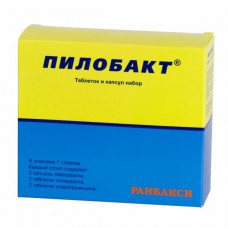Expiration date: 12/2026
Group affiliation:
Anti-ulcer agent
Dosage form:
tablets and capsules set
Pharmacological action:
Combined preparation. It has antimicrobial and anti-ulcer action: omeprazole inhibits secretion of HCl (by inhibiting H+/K+ Atphase - an enzyme located in the membranes of parietal cells of the gastric mucosa), leads to a decrease in basal and stimulated secretion. After oral administration inhibition of gastric secretion occurs within 1 h and continues for 24 hours On the background of repeated administration of 20 mg omeprazole in 24 h gastric acidity is reduced by 97%. Clarithromycin is an antibiotic from the group of macrolides, a semi-synthetic derivative of erythromycin A. it is Effective against a large number of gram-positive, gram-negative and anaerobic microorganisms, including Helicobacter pylori. Tinidazole is Antiprotozoal (disrupts DNA synthesis of bacteria by inhibiting bacterial RNA-dependent protein synthesis), active against Trichomonas, amoebae, lamblia, the causative agents of anaerobic infections and Helicobacter pylori.
Indications:
Peptic ulcer and 12 duodenal ulcer (eradication of Helicobacter pylori).
Contraindications:
Hypersensitivity, chronic liver disease, severe hepatic and/or renal failure, intake of ethanol (disulfiramopodobnaya reactions), jaundice (in history), porphyria, pregnancy (I trimester), lactation, children's age (till 12 years).
Side effect:
Omeprazole: nausea, constipation or diarrhea, abdominal pain, flatulence, headache, dizziness, weakness, skin rash, increased activity of "liver" transaminases, thrombocytopenia, leukopenia, natrosilite, eosinocytes. Clarithromycin: headache, nausea, vomiting, gastralgia, diarrhea, increased activity of "hepatic" transaminases, cholestatic jaundice, the development of secondary resistance of microorganisms, allergic reactions (skin rash, itching), pseudomembranous enterocolitis. Tinidazole: decreased appetite, dry mouth, unpleasant taste in the mouth, nausea, vomiting, diarrhea, headache, urticaria, itching, leukopenia.
Method of application and doses:
Inside. Each blister contains 2 capsules of omeprazole (20 mg), 2 tablets of clarithromycin (250 mg) and 2 tablets of tinidazole (500 mg) and is designed for 1 day of treatment. Take 1 capsule of omeprazole, 1 tablet of clarithromycin and 1 tablet of tinidazole in the morning (LS contained in the orange part of the blister) and repeat taking the above LS in the evening (contained in the blue part of the blister). Each box contains 7 of blisters, which provides treatment for 1 month. Upon completion of the course of eradication therapy, it is recommended to continue taking omeprazole - 20 mg per day for 3 weeks.
Special instruction:
Avoid taking etanolsodergaszczye drinks (perhaps the development disulfiramopodobna reactions). Tinidazole causes dark staining of urine. Before starting treatment, it is necessary to exclude the presence of a malignant disease, especially in patients with gastric ulcer disease, because the use of omeprazole can mask the symptoms of the disease. In the presence of chronic liver diseases, it is necessary to conduct regular monitoring of the activity of "hepatic" transaminases.
Interaction:
Co-administration of clarithromycin and theophylline soprovozdenie increase concentrations of theophylline, terfenadine leads to increased concentration of the latter and may lead to prolongation of Q-T interval, with oral anticoagulants may increase their effect with carbamazepine, cyclosporine, phenytoin, disopyramide, lovastatin, valproate, cisapride, pimozide, astemizole and digoxin may cause an increase of their concentration. Omeprazole slows the metabolism of phenytoin and diazepam, reduces the absorption of ketoconazole, ampicillin and Fe salts (decrease in acid production in the stomach).


